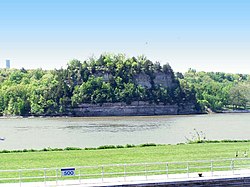Starved Rock Lodge and Cabins
| Starved Rock State Park | |
| Illinois State Park | |
|
Starved Rock as viewed from the north side of the Illinois River.
|
|
| Named for: Starved Rock | |
| Country | United States |
|---|---|
| State | Illinois |
| County | LaSalle County |
| Township | Deer Park |
| Location | LaSalle County, Illinois, USA |
| - coordinates | 41°19′17″N 88°59′25″W / 41.32139°N 88.99028°WCoordinates: 41°19′17″N 88°59′25″W / 41.32139°N 88.99028°W |
| Area | 2,630 acres (1,064 ha) |
| Founded | 1911 |
| Management | Illinois Department of Natural Resources |
| Visitation | 2.1 million |
| IUCN category | III - Natural Monument |
|
Map of the U.S. state of Illinois showing the location of Starved Rock State Park
|
|
| Website: Starved Rock State Park | |
Starved Rock State Park is a state park in the U.S. state of Illinois, characterized by the many canyons within its 2,630 acres (1,064 ha). Located just southeast of the village of Utica, in Deer Park Township, LaSalle County, Illinois, along the south bank of the Illinois River, the park hosts over two million visitors annually, the most for any Illinois state park.
Before European contact, the area was home to Native Americans, particularly the Kaskaskia who lived in the Grand Village of the Illinois across the river. Louis Jolliet and Jacques Marquette were the first Europeans recorded as exploring the region, and by 1683, the French had established Fort St. Louis on a large sandstone butte overlooking the river, they called Le Rocher (the Rock). Later after the French had moved on, according to a local legend, a group of Native Americans of the Illinois Confederation (also called Illiniwek or Illini) pursued by the Ottawa and Potawatomi fled to the butte in the late 18th century. In the legend, around 1769 the Ottawa and Potawatomi besieged the butte until all of the Illiniwek had starved, and the butte became known as "Starved Rock". The area around The Rock was designated a National Historic Landmark in 1960. The park region has been the subject of several archeological studies concerning both native and European settlements, and various other archeological sites associated with the park were added to the National Register of Historic Places in 1998.
...
Wikipedia


